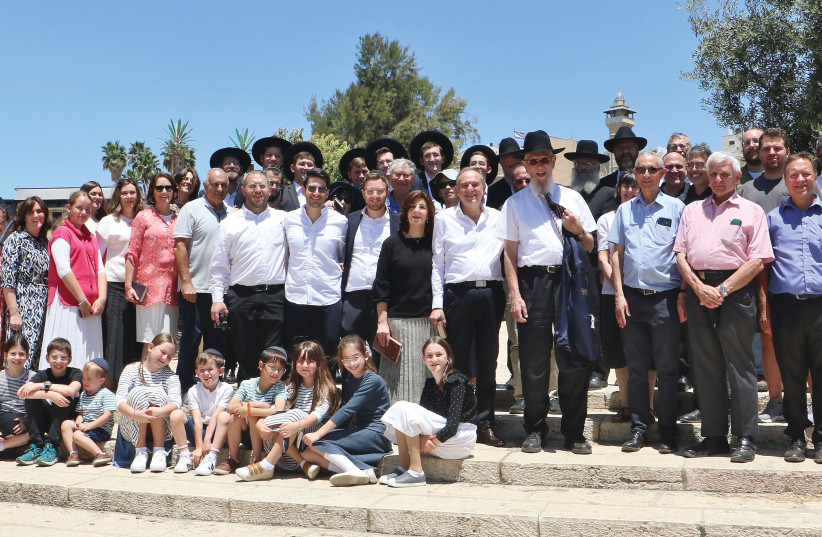A former resident of Gwelo, Zimbabwe had made a life’s goal to find the whereabouts of the Torah his father read from. Thanks to The Jerusalem Post Magazine, he succeeded.
It goes to show: You never know where it is going to go.
A while ago, I heard a moving story about a Torah scroll that belonged to the small Jewish community in Gweru (previously Gwelo), Zimbabwe, which closed its doors in the early 1980s. At the request of Jerusalem’s Menora Organization, the scroll had been smuggled out of the country in 1986 by Gilad and Micky Stern and their four children. It was brought to Israel by South African oleh Roy Scher, and installed in the synagogue in the town of Beit Yatir in the Hebron Hills, where it is in use to this day.
An article I wrote describing the Torah’s trek was printed in the Magazine (May 19) and did the rounds among Jewish Zimbabwean expats. Then a few weeks later, my phone rang. “Hi Richard. You don’t know me. My name is Brian Brom, calling from Johannesburg.”
The evening before, Brom had received a link to the article.
The story of the smuggled Torah continues
Brian had grown up in Gwelo. His father, Myer, like so many of his generation fleeing the pogroms and poverty of Lithuania, had followed opportunity and landed up in Gwelo in 1936. The disparity between the way of life in the stifling shtetl and that of the broad expanses of Southern Africa could not have been starker, and the elder Brom embraced his new world with fervor.
PART OF the traveling contingent at the Tomb of the Patriarchs. (credit: RICHARD SHAVEI-TZION)
His determination to break with the past was later heightened by the shocking discovery that his entire family had been slaughtered in the Holocaust. And yet, with all the anguish he associated with Jewish spiritual life, Myer Brom, a watchmaker by profession, understood that he was the only person in the small local Jewish community who had the skills necessary to lead synagogue services and read from the Torah.
And so, in a remarkable and enduring act of loving-kindness, that is exactly what he did, week after week for over 40 years, supported by his British-born wife, Cynthia.
SHORTLY AFTER Myer died in 1982, the community folded, and the modest synagogue that they had built was eventually sold to a local church.
Brian had left Zimbabwe long before to study accountancy in Johannesburg and had become completely estranged from his Jewish identity. After his father passed away, he took a six-month break to backpack around Europe, and it so happened that the ship he was traveling on from Italy to Greece had a stop in Haifa.
Despite his lack of interest in exploring the city, he decided to stretch his legs and take a walk. As he descended the gangplank, he was confronted by a huge advertising billboard. He had no idea what was written on it, but the cursive Hebrew writing shook his consciousness, for he recognized the same script that he had seen in his father’s desperate letters written after the war in Yiddish in search of his lost Lithuanian family.
“Lieber broeder, liebe shvester…” (“Dear brother, dear sister…”). The letters had sadly been returned to sender. That moment changed Brian’s life forever and signaled the beginning of a journey to his ancestral roots. Brian returned to the boat, picked up his backpack, and headed for Jerusalem.
Among the goals he set for himself was to discover the whereabouts of the Torah scroll from which his father had read with such dedication. Yet despite persistent efforts over decades, it was the one goal he had not achieved. And then he happened upon the article. Astonished, he instantly knew that a mystery that had been haunting him for decades had finally been solved.
ON A typically sweltering August day, a crowd of people gathered at Beit Yatir. They consisted of Brom family members and friends who had traveled from Southern Africa and the US, ex-Southern African Israelis including Dorron Kline – CEO of Telfed, which assists in the integration and welfare of Southern African and other olim – and local community members.
On the bus ride from Jerusalem, the traveling contingent stopped off at Kiryat Arba, for it is there that years before, Brian had dedicated a children’s park in memory of his brother Dr. Les Brom, who had died tragically in a car accident. He could not have known at the time just how close the park was to the location of the scroll that had eluded him for so long.
The memorable event at Beit Yatir sponsored by Brian and his wife, Audrey, was organized by the same Roy Scher who had brought the scroll to Israel from Cape Town so many years before. Tears flowed as the eloquent and impassioned Brom told his story.
After a wonderful luncheon, the crowd gathered in the synagogue. The scroll, adorned with a new mantel (cover) dedicated to the Gwelo community and to the memory of Myer Brom, was carried from the ark to the bima accompanied by joyous dancing and singing. Then, closing the circle, Brian’s son Dovi read from the scroll just as his grandfather had done for so many years.
Brian had mentioned in his speech that when his father died, he knew nothing about saying Kaddish during the year of mourning. As we approached the end of the Mincha service after the ceremony, I suggested to him that it would be appropriate to say Kaddish in his father’s memory at this momentous moment. So it was, that the circle was closed ever tighter.
Source: The Jerusalem Post










